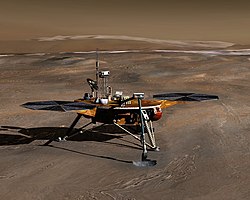Mars Scout Program
Mars Scout Program – program NASA mający za zadanie wysyłanie serii małych i niedrogich misji na Marsa, konkurencyjnie wybieranych z innowacyjnych pomysłów składanych przez społeczeństwo naukowe. Według założeń koszt pojedynczej misji tego programu nie miał przekraczać 500 mln USD[1].
Misje
Pierwszy statek bezzałogowy w tym programie nazywał się Phoenix, lądownik oryginalnie przeznaczony do anulowanej misji Mars Surveyor 2001. Phoenix wystartował 4 sierpnia 2007 roku i wylądował w północnym okołobiegunowym regionie Vastitas Borealis 25 maja 2008 roku[2].
Drugą sondą programu był satelita do badań ewolucji atmosfery marsjańskiej, MAVEN (Mars Atmosphere and Volatile Evolution). Mars Scout Program został oficjalnie zakończony w 2010 roku, ale przygotowania do misji były kontynuowane[3]. Sonda wystartowała 18 listopada 2013 roku, a na orbitę Marsa weszła 22 września 2014[4].
Wobec zakończenia programu, propozycje misji na Marsa zostały włączone do Programu Discovery[5][3]. Jedna z proponowanych misji zwiadowczych, GEMS (Geophysical and Environmental Monitoring Station), została wybrana do realizacji i przemianowana na InSight[6].
Przypisy
- ↑ Mission Classes for Mars Exploration (ang.). W: Solar System Exploration [on-line]. NASA. [dostęp 2014-07-06]. [zarchiwizowane z tego adresu (2012-10-11)].
- ↑ Phoenix Mars Lander (ang.). NASA. [dostęp 2018-05-04].
- ↑ a b Ann Beardsley, C. Tony Garcia, Joseph Sweeney: Historical Guide to NASA and the Space Program. Rowman & Littlefield, 2016, s. 151. ISBN 978-1-4422-6287-4.
- ↑ MAVEN (ang.). W: Mars Exploration Program [on-line]. NASA. [dostęp 2018-05-04].
- ↑ Stephen Clark: Getting to Mars on a budget (ang.). Spaceflight Now, 2010-07-29. [dostęp 2018-05-04].
- ↑ W.B. Banerdt, C.T. RussellEmail. Editorial on: Topical Collection on InSight Mission to Mars. „Space Science Reviews”. 211 (1–4), s. 1–3, 2017. DOI: 10.1007/s11214-017-0414-0 (ang.).
Linki zewnętrzne
- MAVEN (ang.) [dostęp 2012-09-17]
Media użyte na tej stronie
Original Caption Released with NASA Image:
Artist's concept of the Phoenix Mars lander.


